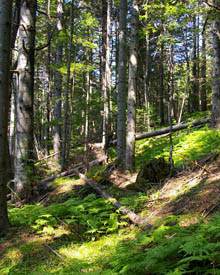
Net carbon refers to the difference between carbon absorbed and emitted. A forest is a source of carbon when emissions exceed sequestration. A forest is a carbon sink when absorption is greater than emissions. Net carbon from a forest is sensitive to natural conditions, forest disturbance, and forest management activities. Wildfire, for example, contributes about 5 percent as much emissions as does the nation’s coal production each year.
Wildfire can turn a forest that is a carbon sink at one time into a carbon source for many years that follow. Because wildfire is a major carbon source, reducing wildfire can help to control carbon emissions from the forest.
There are proposals to remove fuels in the forest to reduce fire severity. The 80/80 rule proposes to decrease woody debris in American forests by 40 to 50 percent which, in turn, would allow about 80 percent of the existing trees to sustain a fire. This can reduce wildfire carbon emissions by as much as 50 percent. But that is a lot of wood removal.
The last several decades have proven difficult for public land managers to remove timber. As wildfire and insect infestation become more prevalent, public forest management may see political tides begin to revert back toward increased timber removal.
Originally posted at Environmental Trends.



